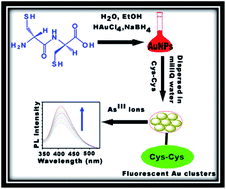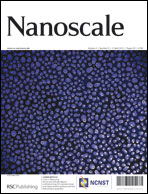The as-prepared gold cluster-based fluorescent sensor for the selective detection of AsIII ions in aqueous solution†
Abstract
Water-soluble fluorescent gold clusters (AuCs) have been successfully synthesized by a wet-chemical approach at room temperature using a dipeptide L-cysteinyl-L-cysteine. We have followed the core-etching mechanism for the synthesis of the gold clusters. Clusters show the excitation maximum at 300 nm and the emission maximum at 410 nm. These gold clusters show interesting fluorescent properties including large Stoke's shift (110 nm), with a quantum yield of 41.3%, and photochemical stability. Transmission electron microscopic analysis shows that most of these particles are <1.5 nm. These clusters have been applied successfully to develop the new fluorescent sensor for the selective and ultra-sensitive detection of AsIII ions in the presence of other bivalent and trivalent metal ions in aqueous solution with a lower detection limit of 53.7 nM and this is far below the permissible limit (133 nM) of arsenic in drinking


 Please wait while we load your content...
Please wait while we load your content...